| 1 | Aruba rattlesnake |
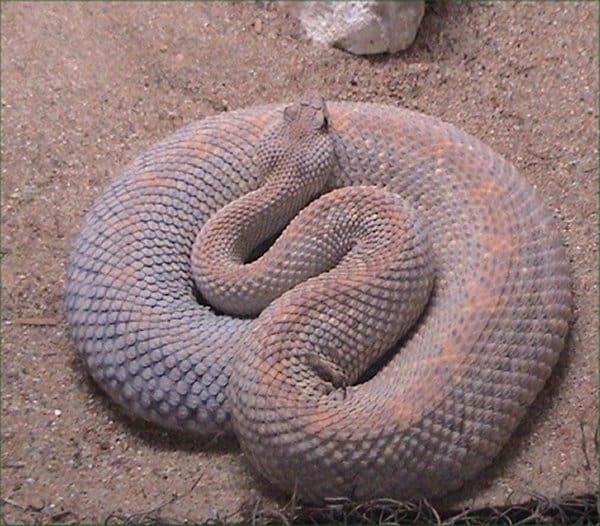
The world’s most endangered rattlesnake. Aruba lies off the coast of Venezuela, a sun-drenched tropical paradise popular with Florida holidaymakers. The island is heavily urbanised, with 106,000 residents packed into its narrow shores. Consequently, the native rattlesnake has been pushed back to a mere 62km zone on the island’s dry southern tip. It’s estimated that only 230 Aruba rattlesnakes survive, in the island’s Arikok National Park. IUCN has listed them as critically endangered since 2007.
This snake lives in a harsh and dry habitat covered with thorny acacia bushes and cacti. They have faint diamond shape markings, occasionally with dull colours, but sometimes an unusual pink.
The rattlesnake isn’t forgotten, as the island’s currency, the florin, bears its image. Education programs have also toured Aruba since 1988, to combat the instinctive fear locals have. Newspapers and magazines got on board, presenting glossy spreads about the rattlesnake’s generally calm nature. An ex situ breeding program is underway, and the Aruba rattlesnake may well survive yet.
| 2 | Albany adder |
This severely endangered snake lives in the eastern cape of South Africa. It’s restricted solely to Coega Bontveld ecosystems, a dry landscape of mixed thicket and scrubland, which are under severe threat from strip mining for limestone pavement.
Barely anything is known about this South African snake, except what the handful of existing photographs can show us. The Albany adder averages at less than 30cm, and is brown and tan to blend with dry soils. Like its dwarf adder cousins, it has horn-like masses of scales above its bulging eyes. It was first discovered in 1937, and 50 years passed until the next sighting in the 1990s. Despite the march of technology, only a single sighting appeared over the next 20 years (2007).
So in late 2016, a Rainforest Trust and Endangered Wildlife Trust team set off to the eastern cape to track down the Albany adder for good. Despite 6 days of constant rummaging and scouting, they only discovered a handful of snakes at the eleventh hour. They were just in time, as they were mere months before the 10 year sighting deadline passed, after which a critically endangered animal is officially declared extinct. It was a heroic effort, but the future remains bleak, as Coega Bontveld habitat continues to be pushed back by mankind.
Albany adders are so unresearched that there are no images we can display, so check out this video instead.
| 3 | Crocker’s sea snake |
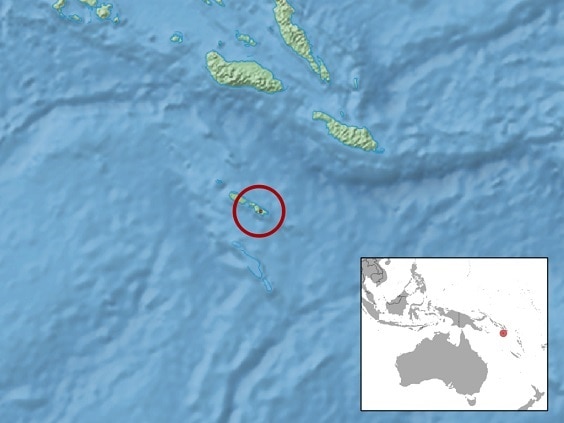
This is one of two purely freshwater seasnakes in the world. Laticauda crockeri not only lives on a single island, but a single brackish, inland lake. The location is Rennel Island, part of the Soloman Islands northeast of Australia. The lake is Lake Te-Nggano, also home to the common banded sea krait (Laticauda colburina). Crocker’s sea snake is most closely related to the black-banded sea krait (Laticauda laticauda), but is believed to have become isolated by sea level or geographical changes. It was propelled down a new path of evolution, with similarly neurotoxic venom, but a smaller body size and a darker appearance.
The downside is that being in one location, an ecological disaster could easily destroy them. The plus side is that Rennel Island is a traditional place of wooden houses and fruit, rather than scorched, smoke-fuelled industry.
A study found that Crocker’s sea snake is unable to breed with the Laticauda colubrina it coexists with. Within the lake, the two species have separated into their own dietary niches, with L. colubrina focussing on Anguilla eels, and Crocker’s sea snake focussing on Eleotris goby fish. While L. colubrina strays to the lake’s sandy shores to rest, Crocker’s sea snake sticks firmly to the water.
| 4 | Anatolian meadow viper |
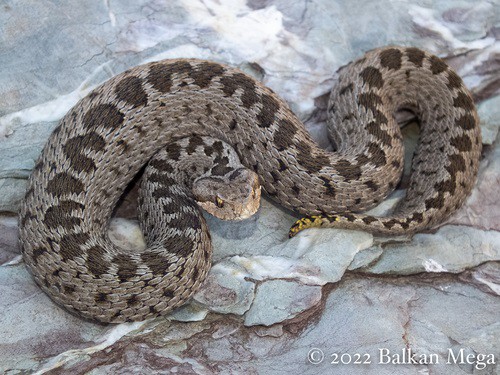
This Turkish viper lives solely in elevations of over 1500 metres, in mountainous sky islands elevated far above the surrounding countryside. This is fun for lording it over other species like a serpent god, but not good if you want a large amount of territory to roam. The Anatolian meadow viper is stranded, as the surrounding Turkish lowlands become far too hot in the summer, exceeding 37C, the viper’s upper temperature limit. With heavy mining activity and quarries, the pressure rises further.
Vipera anatoli branched off 5 million years ago, and is separated by other vipers by hundreds of kilometres. It mainly lives in the Ciglikara mountain plateau, although a new population was discovered in the Geyik Mountains in 2017. This snake moves unbelievably quickly, striking so fast a camcorder can barely keep up. This is designed for its grasshopper-rich diet.
The Anatolian meadow viper was discovered by accident in 1969, by an expedition searching for another endangered animal, the woolly dormouse. In 2013, researchers returned to the Ciglikara mountain plateau and struggled for days to find one on rocky slopes. Finally, a fully grown Vipera anatolica appeared, and the floodgates opened, with over a dozen more appearing in quick succession. Others weren’t so lucky: researcher Harry Sigg spent months searching in the 1980s, and only found 1.
| 5 | Cropani’s boa |
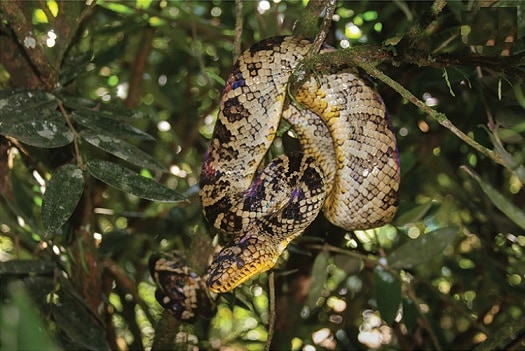
Dubbed the worlds rarest boa, the Cropani’s boa only had a single original sighting in 1953. South America is littered with ghost snakes that were documented once and never reappeared, and over the next few decades the only fresh evidence that washed up was a handful of dead boas. Its territory was the Atlantic Forest near Sao Paulo, which is becoming increasingly slashed down.
Conservationists put out a forest-wide alert, and in 2017, their prayers were answered, as a live Cropani’s boa was finally found. It had a beige body with contrasting splashes of dark brown, and measured 1.7 metres. It had the usual primitive head of boas, but on the goofy side rather than cruel.
For once, this was captured by locals instead of scared-looking scientists, who had been taught to safely store the snake in a plastic bucket. Previous locals had beaten them to death, as its relatives had a reputation of being “a bit bitey”. This comes from their hunting style, where they drag prey up into branch perches before swallowing them. Barely anything is known about the Cropani’s boa except its attraction to trees.
| 6 | McGregor’s pitviper |
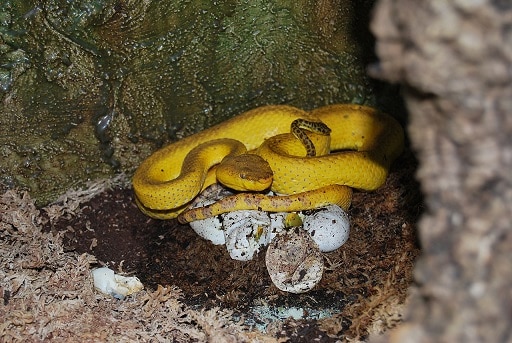
This 1 metre pitviper lives solely on the small Batanes islands off the far north Philippine coast. They stick to seasonal rainforests receiving slighter lower quantities of rainfall, at 2000-3000mm per year. This snake is always found below 300 metres in altitude. Unlike Trimeresurus flavomaculatus on the Philippine mainland, McGregor’s pitviper relies on mammals. It was named after Richard McGregor, the first man to collect one, who survived its venomous bite.
This pitviper is very variable in the wild – some are chocolate brown, some have leopard patterns, some are white with black markings, but none have the bright green typical of the Trimeresurus family. Unfortunately, these flashy colours are making it popular in the international pet trade. Many specimens are harvested from the wild, and consequently, Trimeresurus mcgregori is considered to be one of the top 30 endangered vipers worldwide. With their very small island base, there’s nowhere for this species to flee to.
Thankfully, efforts have been underway since 2000 to save this species. This breeder mastered the art of T. mcgregori and ultimately produced several hundred, which he released back into the Batanes Island wilds, with the cooperation of local officials. The governor of the Batanes Islands was all set to make their habitat a projected zone.
| 7 | Antiguan racer |
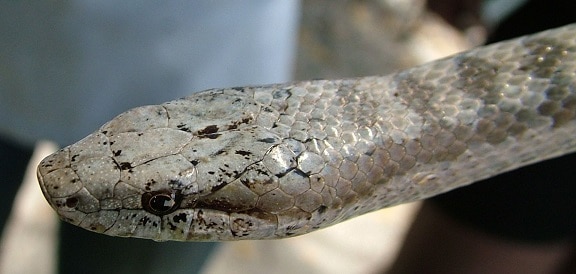
In the late 1990s, the Antiguan racer was the rarest snake in the world. This is a grey, 1 metre snake which primarily preys on anoles, and poses no threat to mankind. Before European colonists arrived, it roamed Antigua with no limits, and no natural predators, through neverending forests.
The first danger was deforestation for sugar plantations, and then European ships accidentally brought black rats across the Atlantic. Farmers released the Asian mongoose to deal with them, but these targeted the Antiguan racer instead. By 1936, it was considered extinct. In the 1960s, it was sighted on Great Bird Island, which was considered to be the snake’s last gasp. But in 1995, reports of survivors from the island could no longer be ignored. This mongoose-free island turned out to be the Antiguan racer’s last refuge, with a mere 51 adults surviving.
Rats had already invaded the island, and were gnawing at the snakes’ tails. So scientists got to work, and positioned wax blocks laced with anticoagulant poison brodifacoum all over. Some team members were forced to climb crumbling cliffsides to ensure that no spot was missed. By 2000, the Antiguan racer was still languishing at a mere 81 adults. But by 2010, numbers had risen to 100, and conservationists also began replenishing nearby islands such as Green Island.
The Antiguan racer remains endangered, but its population is now estimated at 1000.
| 8 | St Lucia Racer |
Possibly the world’s rarest snake. This has fallen into the exact same scenario as the Antiguan racer. Erythrolamprus ornatus was once widespread across St Lucia, in forested realms decimated by sugar plantations. They plummeted further when the snake-hungry Asian mongoose was introduced in 1872, and by 1936 they were officially declared extinct. Hope was revived with a single sighting in 1973, but that was it for 39 years. Not one scientific report came in, not even a sketchy sighting from a local farmer.
In 2012, a team of scientists scoured St Lucia, and their search took them to Maria Major, a small island 800 metres off the St Lucia mainland. They knew that the rocky, uninhabited island was free from mongeese, and after 5 months of relentless searching, they found 11 St Lucia racers, perhaps the species’ last survivors after millions of years of evolution. They estimated that 20 remained in total, meaning that genetic diversity is a serious issue. The 11 snakes were radio tagged, and set to provide 10 years worth of data.
The St Luci racer a is a brown snake with green tinges, and occasional yellow spots. It has a timid disposition and reaches 1.25 metres long. Maria Major is also a refuge for the Saint Lucia whiptail lizard, with 90% of survivors.
| 9 | Santa Catalina rattlesnake |

25 kilometres off the east coast of Baja California, Mexico lies Santa Catalina Island. This is a completely uninhabited island, which looks very tempting to make a base on. There’s a small rocky bay, and then the endless shrubs and spiky cacti begin. It’s a scenic oasis with blue skies and the occasional wispy cloud, but it’s perfectly possible to die here and never be seen again. The island has 7 unique reptiles, one being the severely endangered Santa Catalina rattlesnake.
At a maximum of 73.1cm, this species is fairly small, though not as dwarfed as the pygmy rattlesnake of Florida. It possesses the usual venom, but is a rare rattlesnake species to lack a rattle. The “button” that holds the rattles is now so devolved that the new segments fall off whenever the snake sheds its skin.
This rattlesnake is believed to be most closely related to the red diamond rattlesnake (Crotalus ruber). The conservation situation is severe, as Crotalus catalinensis is now listed as critically endangered by IUCN. Its home range is a mere 40 square kilometres, and amateur collection and aggressive feral cats add to the pressure.
| 10 | Round Island boa |
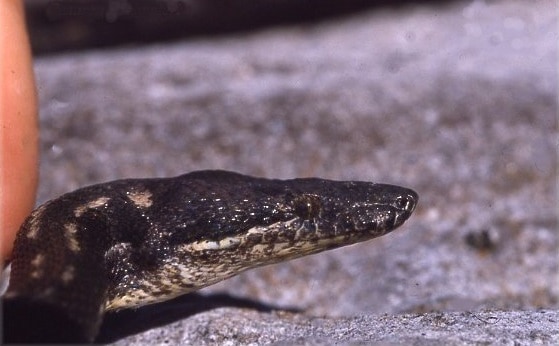
This differs from the Cropani’s boa, in that everyone knows where it is, but it’s confined to a small area. That snake pit is Round Island, Mauritius, 1200 miles off the southeast coast of Africa. This is purely an ecological reserve, and suffered serious damage in the 19th century as goats and rabbits were introduced. These herbivores grazed on the native fauna, munching away to their hearts’ content, but this caused catastrophic damage to the local food chain. Resident lizards fell, as did snakes. It took until 1979 to eradicate the goats, while rabbits were eradicated in 1986 using the same brodifacoum anticoagulant toxin used to help Antiguan racers.
By 1996, the Round Island boa (Casarea dussumieri) was estimated at less than 250 individuals. These days, it’s a far healthier 1000 plus. The loss would have been doubly severe, as this snake is the sole member of its genus, Casarea. The Round Island boa measures just 50cm, and has a shiny black colour, while its beady eyes are similar to the sunbeam snakes of Thailand. Casarea dussumieri changes colour in a constant 24 hour cycle, shifting from dark during daytime to lighter at night. The island also hosted the Round Island burrowing boa until 1975, which wasn’t so lucky – the goat and rabbit pressure forced it into official extinction (you never know though).
